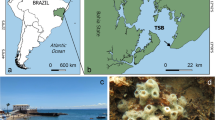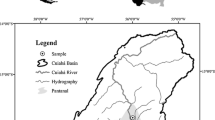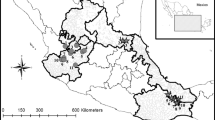Abstract
Although the Orton’s rule was already questioned for several invertebrate lineages, it remains unchallenged in sponges. To assess its validity in Porifera, we investigated the reproductive cycle of five species of Demospongiae on a tropical rocky shore, aiming to determine the effect of some environmental variables (EVs) on the periodicity, density of reproductive elements, and population engagement in reproduction. All species reproduced continuously, with low percentage of reproductive individuals and low fecundity. Each species presented a set of models containing different EVs to explain their reproductive traits. In general, the relationship of the EVs on the percentage of reproductive individuals and density of gametes and embryos was delayed in 1–3 months. Temperature was amongst the factors that best explained the species reproduction, with a delay of 1 month being the factor most consistently found amongst the models. In addition, we carried out a meta-analysis and discovered that in temperate regions most species reproduced periodically, whilst in the tropics, a small percentage reproduced continuously. Our findings suggest that Orton’s Rule is partially sustained, as species reproduced continuously, but challenge the lack of the influence of the temperature and other EVs in the reproduction of tropical marine invertebrates.








Similar content being viewed by others
References
Anderson, D. R., 2008. Model based inference in the life sciences: a primer on evidence. Springer, New York.
Asa, S., T. Yeemin, N. Chaitanawisuti & A. Kritsanapuntu, 2000. Sexual reproduction of a marine sponge, Petrosia sp. from coral communities in the Gulf of Thailand. Proceeding of the 9th International Coral Reef Symposium: 421–424
Ayling, A. L., 1980. Patterns of sexuality, asexual reproduction and recruitment in some subtidal marine Demospongiae. Biological Bulletin 158: 271–282.
Aviz, D., A. J. A. Pinto, M. A. P. Ferreira, R. M. Rocha & J. S. Rosa Filho, 2016. Reproductive biology of Sabellaria wilsoni (Sabellariidae: Polychaeta), an important ecosystem engineer on the Amazon coast. Journal of the Marine Biological Association of the United Kingdom. 1–12
Baldacconi, R., C. Nonnis-Marzano, E. Gaino & G. Corriero, 2007. Sexual reproduction, larval development and release in Spongia officinalis L. (Porifera, Demospongiae) from the Apulian coast. Marine Biology 152: 969–979.
Bauer, R. T., 1989. Continuous reproduction and episodic recruitment in nine shrimp species inhabiting a tropical seagrass meadow. Journal of Experimental Marine Biology and Ecology 127: 175–187.
Bauer, R. T., 1992. Testing generalizations about latitudinal variation in reproduction and recruitment patterns with sicyoniid and caridean shrimp species. Invertebrate Reproduction and Development 22: 193–202.
Bautista-Guerrero, E., J. L. Carballo & M. Maldonado, 2010. Reproductive cycle of the coral-excavating sponge Thoosa mismalolli (Clionaidae) from Mexican Pacific coral reefs. Invertebrate Biology 129: 285–296.
Becerro, M. A., 2008. Quantitative trends in sponge ecology research. Marine Ecology 29: 167–177.
Burnham, K. P. & D. R. Anderson, 2002. Model selection and multimodel inference: a practical information-theoretic approach. Springer Science & Business Media, New York.
Ceuta, L. O. & G. Boehs, 2012. Reproductive cycle of Tagelus plebeius (Mollusca: Bivalvia) in the estuary of the Cachoeira River, Ilhéus, Bahia, Brazil. Brazilian Journal of Biology 72: 569–576.
Chia, F.-S. & C. W. Walker, 1991. Echinodermata: Asteroidea. In Giese A.& V. Pearse (eds) Reproduction of Marine Invertebrates Vol. VI. Boxwood Press, Pacific Groove: 301–353
Corriero, G., M. Sarà & P. Vaccaro, 1996. Sexual and asexual reproduction in two species of Tethya (Porifera: Demospongiae) from a Mediterranean coastal lagoon. Marine Biology 126: 175–181.
Darling, E. S., N. A. J. Graham, F. A. Januchowski-Hartley, K. L. Nash, M. S. Pratchett & S. K. Wilson, 2017. Relationships between structural complexity, coral traits, and reef fish assemblages. Coral Reefs 36: 561–575.
de Goeij, J. M., D. van Oevelen, M. J. A. Vermeij, R. Osinga, J. J. Middelburg, A. F. P. M. de Goeij & W. Admiraal, 2013. Surviving in a marine desert: the sponge loop retains resources within coral reefs. Science 342: 108–110.
Di Camillo, C. G., M. Coppari, I. Bartolucci, M. Bo, F. Betti, M. Bertolino, B. Calcinai, C. Cerrano, G. De Grandis & G. Bavestrello, 2012. Temporal variations in growth and reproduction of Tedania anhelans and Chondrosia reniformis in the North Adriatic Sea. Hydrobiologia 687: 299–313.
Elvin, D. W., 1976. Seasonal growth and reproduction of an intertidal sponge, Haliclona permollis (Bowerbank). Biol Bull 151: 108–125.
Ereskovsky, A. V., 2000. Reproduction cycles and strategies of the cold-water sponges Halisarca dujardini (Demospongiae, Halisarcida), Myxilla incrustans and Iophon piceus (Demospongiae, Poecilosclerida) from the White Sea. Biological Bulletin 198: 77–87.
Ereskovsky, A. V., 2010. The comparative embryology of sponges. Springer, Dordrecht, Heidelberg.
Ereskovsky, A., M. Dubois, J. Ivanišević, E. Gazave, P. Lapebie, D. Tokina & T. Pérez, 2013. Pluri-annual study of the reproduction of two Mediterranean Oscarella species (Porifera, Homoscleromorpha): cycle, sex-ratio, reproductive effort and phenology. Marine Biology 160: 423–438.
Ettinger-Epstein, P., S. W. Whalan, C. N. Battershill & R. de Nys, 2007. Temperature cues gametogenesis and larval release in a tropical sponge. Marine Biology 153: 171–178.
Fromont, J., 1994. Reproductive development and timing of tropical sponges (Order Haplosclerida) from the Great-Barrier-Reef, Australia. Coral Reefs 13: 127–133.
Fromont, J. & P. R. Bergquist, 1994. Reproductive biology of three sponge species of the genus Xestospongia (Porifera: Demospongiae: Petrosida) from the Great Barrier Reef. Coral Reefs 13: 119–126.
Genta-Jouve, G. & O. P. Thomas, 2012. Sponge Chemical Diversity: From Biosynthetic Pathways to Ecological Roles. In Becerro, M. A., M. J. Uriz, M. Maldonado & X. Turon (eds), Advances in Marine Biology. Academic Press, Amsterdam: 183–230.
Giese, A. C., 1959. Comparative physiology: annual reproductive cycles of marine invertebrates. Annual Review of Physiology 21: 547–576.
Gregg, W. W. & N. W. Casey, 2004. Global and regional evaluation of the SeaWiFS chlorophyll data set. Remote Sensing of Environment 93: 463–479.
Hajdu, E., S. Peixinho & J. C. C. Fernandez, 2011. Esponjas marinhas da Bahia: guia de campo e laboratório. Museu Nacional, Rio de Janeiro.
Hoppe, W. F., 1988. Reproductive patterns in three species of large coral reef sponges. Coral Reefs 7: 45–50.
Jaeckle, W. B., 1995. Transport and metabolism of alanine and palmitic acid by field-collected larvae of Tedania ignis (Porifera, Demospongiae): estimated consequences of limited label translocation. Biological Bulletin 189: 159–167.
Kaye, H. R. & H. M. Reiswig, 1991. Sexual reproduction in four Caribbean commercial sponges. I. Reproductive cycles and spermatogenesis. Invertebrate Reproduction and Development 19: 1–11.
Lanna, E. & M. Klautau, 2016a. Life history and reproductive dynamics of the cryptogenic calcareous sponge Sycettusa hastifera (Porifera, Calcarea) living in tropical rocky shores. Journal of the Marine Biological Association of the United Kingdom. Early view
Lanna, E. & M. Klautau, 2016b. Some aspects of the oogenesis of three species of clathrinid sponges (Calcarea, Porifera). Journal of the Marine Biological Association of the United Kingdom 96: 529–539.
Lanna, E., R. Paranhos, P. C. Paiva & M. Klautau, 2015. Environmental effects on the reproduction and fecundity of the introduced calcareous sponge Paraleucilla magna in Rio de Janeiro, Brazil. Marine Ecology 36: 1075–1087.
Lanna, E., L. Rattis & F. F. Cavalcanti, 2017. The presence of the diagnostic character of the genus Paraleucilla (Amphoriscidae, Calcarea, Porifera) may depend on the volume and body wall thickness of the sponges. Invertebrate Biology 136: 321–329.
Legendre, P., 2005. Species associations: the Kendall coefficient of concordance revisited. Journal of Agricultural, Biological and Environmental Statistics 10: 226–245.
Leite-Castro, L. V., J. Souza Junior, C. S. B. Salmito-Vanderley, J. F. Nunes, J.-F. Hamel & A. Mercier, 2016. Reproductive biology of the sea cucumber Holothuria grisea in Brazil: importance of social and environmental factors in breeding coordination. Marine Biology 163: 1–13.
Lessa, G. C., M. Cirano, F. Genz, C. A. S. Tanajura & R. R. Silva, 2009. Oceanografia física. In: Hatje, V. & J. B. D. Andrade (EdS), Baía de Todos os Santos: aspectos oceanográficos. EDUFBA, Salvador: 69–119
Lyngsgaard, M. M., S. Markager, K. Richardson, E. F. Møller & H. H. Jakobsen, 2017. How well does chlorophyll explain the seasonal variation in phytoplankton activity? Estuaries and Coasts 40: 1263–1275.
Maldonado, M. & A. Riesgo, 2009. Gametogenesis, embryogenesis, and larval features of the oviparous sponge Petrosia ficiformis (Haplosclerida, Demospongiae). Marine Biology 156: 2181–2197.
Maldonado, M. & C. M. Young, 1996. Effects of physical factors on larval behavior, settlement and recruitment of four tropical demosponges. Marine Ecology Progress Series 138: 169–180.
Maldonado, M., M. Ribes & F. C. van Duyl, 2012. Nutrient fluxes through sponges. Advances in Marine Biology 62: 113–182.
Maria, M., G. Corriero, M. Gherardi, R. Baldacconi & E. Gaino, 2013. Sexual reproduction in Sarcotragus spinosulus from two different shallow environments. Marine Ecology 34: 394–408.
Mariani, S., M. J. Uriz & X. Turon, 2005. The dynamics of sponge larvae assemblages from northwestern Mediterranean nearshore bottoms. Journal of Plankton Research 27: 249–262.
Mercier, A. & J. F. Hamel, 2009. Endogenous and exogenous control of gametogenesis and spawning in echinoderms. Advances in Marine Biology 55: 1–302.
Meroz-Fine, E., S. Shefer & M. Ilan, 2005. Changes in morphology and physiology of an East Mediterranean sponge in different habitats. Marine Biology 147: 243–250.
Nozawa, Y., Y. S. Huang & E. Hirose, 2016. Seasonality and lunar periodicity in the sexual reproduction of the coral-killing sponge, Terpios hoshinota. Coral Reefs 35: 1071–1081.
Olive, P. J. W., 1995. Annual breeding cycles in marine invertebrates and environmental-temperature—Probing the proximate and ultimate causes of reproductive synchrony. Journal of Thermal Biology 20: 79–90.
Orton, J. H., 1920. Sea temperature, breeding and distribution in marine animals. Journal of the Marine Biological Association of the United Kingdom 12: 312–326.
Perez, V., E. Fernandez, E. Maranon, P. Serret & C. Garcia-Soto, 2005. Seasonal and interannual variability of chlorophyll-a and primary production in the Equatorial Atlantic: In situ and remote sensing observations. Journal of Plankton Research 27: 189–197.
Pires, D. O., C. B. Castro & C. C. Ratto, 1999. Reef coral reproduction in the Abrolhos Reef Complex, Brazil: the endemic genus Mussismilia. Marine Biology 135: 463–471.
R Developmental Core Team, 2015. R: A language and environment for statistical computing. R foundation for Statistical Computing, Vienna, Austria. ISBN 3-900051- 07-0, Available online at: http://www.R-project.org/
Reiswig, H. M., 1976. Natural gamete release and oviparity in Caribbean Demospongiae. Aspects of Sponge Biology, New York: 25–27.
Riesgo, A. & M. Maldonado, 2008. Differences in reproductive timing among sponges sharing habitat and thermal regime. Invertebrate Biology 127: 357–367.
Riesgo, A., M. Maldonado & M. Durfort, 2007. Dynamics of gametogenesis, embryogenesis, and larval release in a Mediterranean homosclerophorid demosponge. Marine and Freshwater Research 58: 398–417.
Riesgo, A., M. Novo, P. P. Sharma, M. Peterson, M. Maldonado & G. Giribet, 2013. Inferring the ancestral sexuality and reproductive condition in sponges (Porifera). Zoologica Scripta 43: 101–117.
Riesgo, A., S. Taboada, L. Sánchez-Vila, J. Solà, A. Bertran & C. Avila, 2015. Some like It fat: comparative ultrastructure of the embryo in two demosponges of the genus Mycale (Order Poecilosclerida) from Antarctica and the Caribbean. PLoS ONE 10: e0118805.
Scrosati, R. A. & J. A. Ellrich, 2016. A 12-year record of intertidal barnacle recruitment in Atlantic Canada (2005-2016): relationships with sea surface temperature and phytoplankton abundance. PeerJ 4: e2623.
Simpson, T. L., 1984. The cell biology of sponges. Springer-Verlag, New York.
Smart, T. I., C. M. Young & R. B. Emlet, 2012. Environmental cues and seasonal reproduction in a temperate estuary: a case study of Owenia collaris (Annelida: Polychaeta, Oweniidae). Marine Ecology 33: 290–301.
Storr, J. F., 1964. Ecology of the Gulf of Mexico commercial sponges and its relation to the fishery. US Department of Interior, Fish and Wildlife Service, Washington.
Stubler, A. D., H. Robertson, H. J. Styron, J. M. Carroll & C. M. Finelli, 2017. Reproductive and recruitment dynamics of clionaid sponges on oyster reefs in North Carolina. Invertebrate Biology
Thorson, G., 1950. Reproductive and larval ecology of marine bottom invertebrates. Biological Reviews 25: 1–45.
Vacelet, J., 1979 Quelques stades de la reproduction sexuée d’une éponge sphinctozoaire actuelle. In: Levi C. & N. Boury-Esnault (eds) Biologie des Spongiaires - Sponge Biology Centre National de la Recherche Scientifique, Paris, pp 95–101
Weyrer, S., K. Ruetzler & R. Rieger, 1999. Serotonin in cells of Tedania ignis (Porifera, Poecilosclerida). Memoirs of the Queensland Museus 44: 659–666.
Whalan, S., C. Battershill & R. de Nys, 2007. Sexual reproduction of the brooding sponge Rhopaloeides odorabile. Coral Reefs 26: 655–663.
Acknowledgements
We are grateful to all the students in our lab (LEBR) that helped in collecting the sponges during the study. We thank Andre L. Cruz a researcher of the National Institute of Science and Technology in Comparative Physiology (INCT—Fisiologia Comparada) who enabled the use of equipment from the Laboratory of Animal Physiology (LAFISA/UFBA) and Guilherme Lessa for providing data on seawater temperature. We also thank Jaaziel E. Garcia Hernandez (University of Puerto Rico at Mayagüez) for reviewing the English style and grammar of the manuscript. BC, CSS, JH, and UP received fellowships of the Programa de Bolsas de Iniciação Científica (PIBIC) of UFBA. VV was benefited by a PhD scholarship from CAPES. Research in our lab is financially supported by the Brazilian National Council of Technological and Scientific Development (CNPq: 477227/2013-9), Fundação de Amparo à Pesquisa do Estado da Bahia (FAPESB: JCB0014/2016) and PROPCI/PRODOC-UFBA. Our lab is part of the National Institute of Science and Technology in Interdisciplinary and Transdisciplinary Studies in Ecology and Evolution (INCT IN-TREE).
Author information
Authors and Affiliations
Corresponding author
Additional information
Handling editor: Iacopo Bertocci
Bruno Cajado, Carine Santos-da-Silva, Jéssica da Hora, Ubaldo Porto and Vivian Vasconcellos have contributed equally to this work.
Electronic supplementary material
Below is the link to the electronic supplementary material.
Rights and permissions
About this article
Cite this article
Lanna, E., Cajado, B., Santos-da-Silva, C. et al. Is the Orton’s rule still valid? Tropical sponge fecundity, rather than periodicity, is modulated by temperature and other proximal cues. Hydrobiologia 815, 187–205 (2018). https://doi.org/10.1007/s10750-018-3562-7
Received:
Revised:
Accepted:
Published:
Issue Date:
DOI: https://doi.org/10.1007/s10750-018-3562-7




